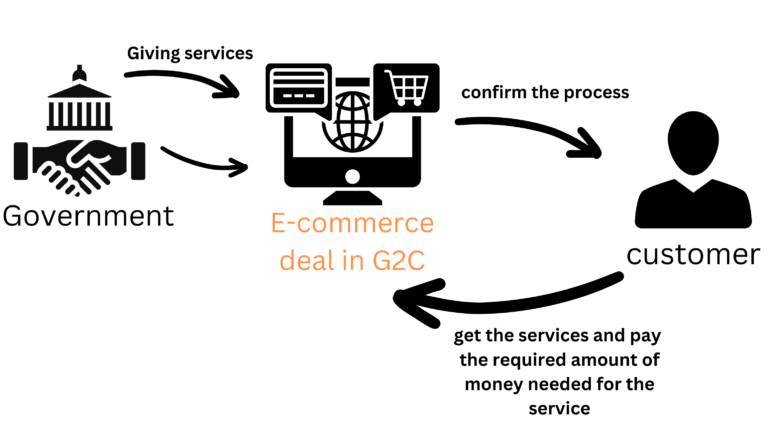WHAT IS E-COMMERCE
E-COMMERCE stands for electronic commerce and refers to the buying and selling of goods and services over the Internet or other electronic devices with the Internet. It involves conducting commercial transactions electronically, typically through websites, online marketplaces, or mobile apps. To conduct e-commerce transactions there are some of its business models according to its transactions deal with people.
E-commerce encompasses various business model activities, including online retailing, online auctions, digital product downloads, and electronic payments. Businesses leverage e-commerce to reach a global audience, streamline operations, reduce overhead costs, and provide convenient shopping experiences for customers. Key components of e-commerce include online storefronts, secure payment gateways, inventory management systems, order fulfillment processes, and customer relationship management (CRM) tools.
In this article, we are going to discuss the important E-commerce business models That work in actual life.
E-commerce Business Models

B2B – stands for Business to Business. In this model the selling and buying of good and all the transactions and services happens between two businesses via online systems. That type of relationship can be seen in producers and wholesalers, or some other business-to-business deals.B2B deals can also be like- a door-making company buying glasses from a glass company.
- It is convenient for companies to take their invoices and transactions of bulk orders just to be completed within a few clicks.
- In B2B the transactions are mostly in bulk orders, which will give them huge rates of discounts on buying the products and they also get online discounts, so they earn huge profits.
- Everything is online so there is end-to-end encryption in transactions. there is less concern of any money theft in between transactions.
- With online B2B transactions you can access any new markets. globally.
- The online process sometimes could be more complex, Like in first how to get started and deal with bulk orders.
- Increased the B2B competition, as there are many choices available in the online market.
- Not suitable for very small sellers. to deal with large corporates.
- Complex payment processing system for the new users.
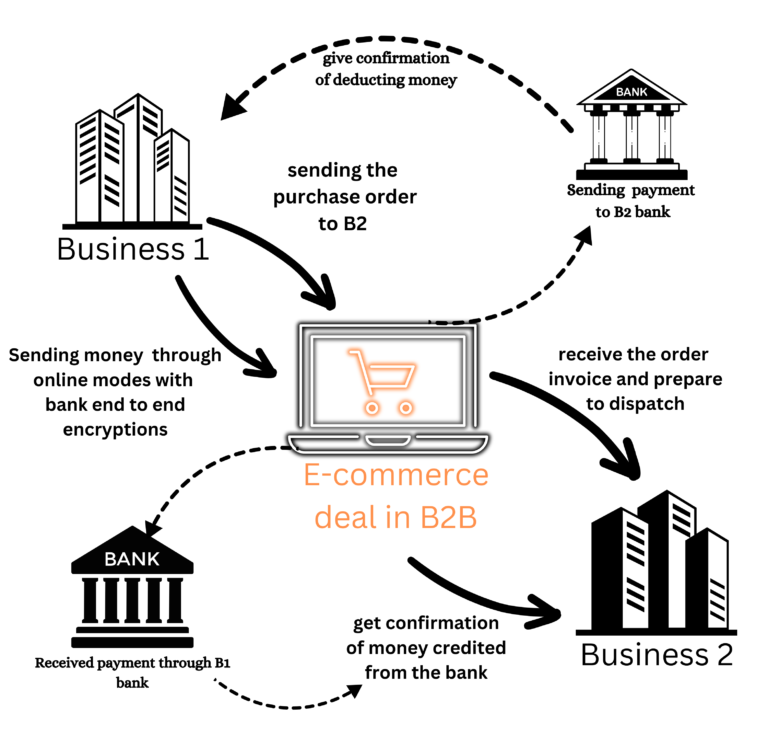
B2C – stands for Business to Consumer or we can also call it D2C Direct to Consumer. It is mostly used everywhere. In B2C the business sells its goods to the consumer or the end-user directly by eliminating the middleman. that is why it is called direct-to-consumer. It is a very good option for a person who wants to buy goods at a reasonable price.
- Unlimited choices in the e-market with different prices at different places.
- Lower every cost of going to market and for the seller to manage all the products.
- Admin work getting easier to manage at just one site.
- Availability time is not only limited to working hours. You can get anything at anytime
- No infrastructure intangible place needs always internet connections some people will not still have access to the e-commerce world.
- Lack of trust is built up if someone gets the wrong delivery or any fraud happens to the customer.
- It completely depends on the internet, if the connection goes, E-commerce goes as well.
- Always stress checking the product deliveries if it is received wrong then the return process takes so long time.
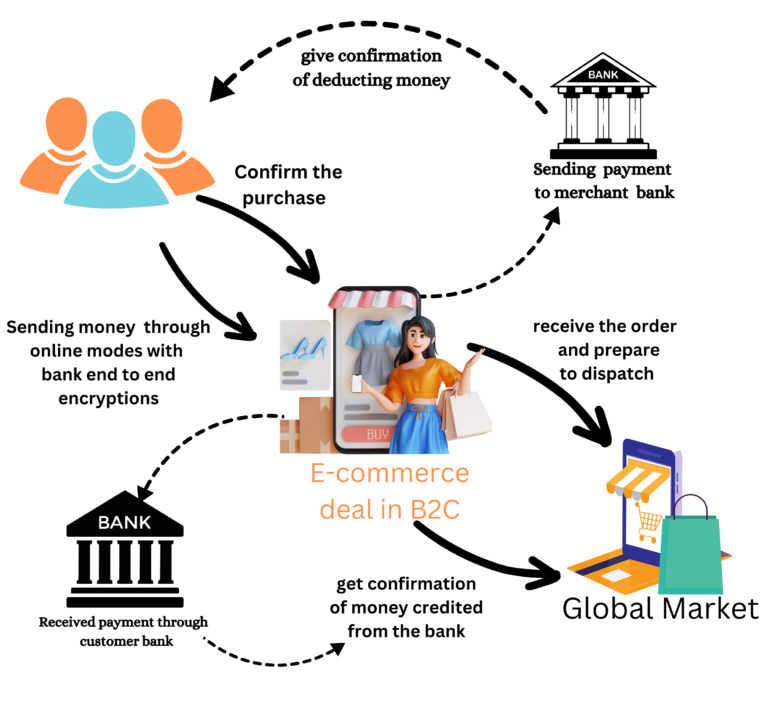
C2B- stands for Customer to Business where the consumer sells their goods or any services to a business or an Industry. In which the customer labels and prices the product. Anyone can buy the product Example- reverse auctions, and services like- a job that is fee-based.
- Give an individual to start their career and build up a moral to boost their confidence.
- Businesses can access a diverse talent pool of individuals with specialized skills or unique offerings that may not be available within their own organization.
- C2B transactions can be cost-effective for businesses, as they may pay only for the specific services or products they need, without incurring the overhead costs associated with hiring full-time employees or maintaining in-house resources.
- Businesses can quickly scale their operations by tapping into the skills and resources of a large pool of individual contributors.
- C2B transactions may be less reliable than traditional business-to-business transactions, as individual consumers may lack the professionalism, reliability, or accountability of established businesses.
- Effective communication and coordination between businesses and individual consumers are crucial for successful C2B transactions
- Businesses relying on C2B transactions may face risks associated with the dependency on individual contributors, including availability, turnover, or changes in market conditions.
- Building trust and establishing a positive reputation with individual consumers can be essential for businesses to maintain ongoing relationships in the C2B model.
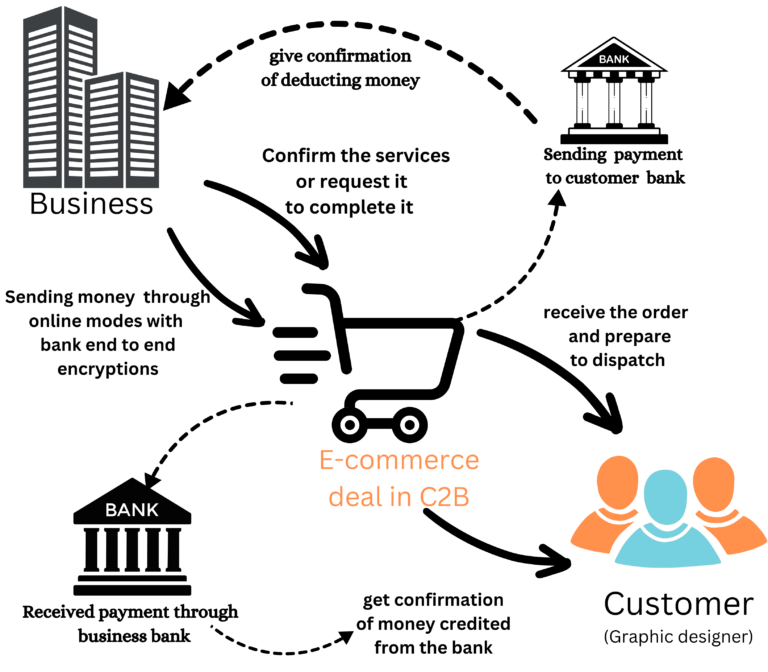
C2C- stands for Customer to Customer. It deals in the buying and selling of goods and services between one customer with another customer. It is done with a third-party platform like- OLX, eBay, etc. The third party also gets profits for using this system, margins can be higher than traditional methods for sellers as there are minimal costs due to the absence of retailers.
- C2C platforms facilitate direct interaction between buyers and sellers, enabling consumers to ask questions, negotiate terms, and provide feedback directly to sellers.
- Consumers can shop from the comfort of their homes or on the go, with C2C platforms offering convenient browsing, purchasing, and payment options.
- Buying and selling used or pre-owned items on C2C platforms can promote sustainability by extending the lifecycle of products and reducing waste.
- it can used products so the price is very low.
- Ensuring the quality and authenticity of products or services on C2C platforms can be challenging, as individual sellers may vary in terms of reliability, honesty, and adherence to standards.
- C2C transactions involve inherent risks, including payment disputes, delivery issues, and dissatisfaction with products or services, which may lead to conflicts or negative experiences for consumers.
- Sharing personal information, such as contact details and payment information, on C2C platforms can raise privacy concerns and vulnerabilities to data breaches or identity theft.
- Trust and reputation are critical in C2C transactions, and consumers may face risks associated with fraudulent sellers, misleading product descriptions, or unreliable transactions.

B2G – stands for Business to Government. it is also called B2A(administration) The government also gets some services or products from businesses. It refers to transactions where businesses sell products or services to government entities. EG- getting raw materials from companies to make a government school.
- Governments at various levels (local, regional, national) procure a wide range of goods and services, creating a large and diverse market for businesses to tap into.
- Governments are major consumers with stable demand for various goods and services, providing businesses with reliable revenue streams and long-term contracts.
- Government agencies may seek innovative solutions and technologies to address public needs, providing businesses with opportunities to showcase their expertise and develop cutting-edge products or services.
- Government contracts often come with stable regulatory frameworks, reducing uncertainty and volatility for businesses compared to consumer markets or private-sector contracts.
- Government processes are often highly competitive, with multiple businesses vying for contracts through competitive bidding, tendering, or request for proposal (RFP) processes.
- B2G transactions typically involve complex procurement processes, bureaucratic red tape, and extensive documentation requirements, which can be time-consuming and resource-intensive for businesses.
- Government procurement decisions may be influenced by political factors, changes in administration, or regulatory shifts, introducing additional risks and uncertainties for businesses.
- Government payment processes may be slow and bureaucratic, leading to delays in receiving payments for goods or services rendered, which can strain cash flow and financial stability for businesses.

G2B- stands for Government to Business. The model is where the government sells its services or goods to a business in exchange for money. The Admin can also need some services as well as goods to perform their work That’s why it deals with companies as well as with Customers.
- Businesses can access a wide range of information and resources provided by government agencies, including regulatory requirements, industry data, market research, and business support services.
- G2B platforms often offer streamlined processes for business registration, licensing, permitting, and compliance, reducing administrative burdens and bureaucratic red tape for businesses.
- Government agencies may offer compliance assistance, training programs, and advisory services to help businesses navigate regulatory requirements.
- G2B services and resources provided by government agencies may be offered at subsidized or reduced costs, enabling businesses to access essential services, training programs, and incentives to support their growth and competitiveness.
- G2B services and information may be fragmented across multiple government agencies, departments, and jurisdictions, making it challenging for businesses to navigate and access relevant resources efficiently.
- G2B platforms may raise security and privacy concerns related to the protection of sensitive business information, intellectual property, and personal data shared with government agencies, especially in cases of data breaches or cyberattacks.
- Businesses relying heavily on G2B services and support may become overly dependent on government initiatives, policies, and funding, exposing them to risks associated with changes in government priorities, funding cuts, or regulatory shifts.
- G2B interactions may still involve bureaucratic processes, paperwork, and delays, particularly in cases where government agencies have not fully digitized or streamlined their services, hindering business agility and efficiency.
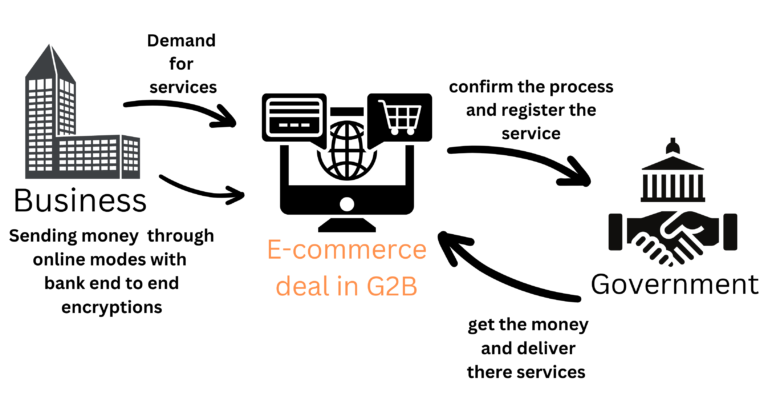
C2G- stands for the Customer to Government. All the services and exchanges are performed between the customer and the government is called the C2G model. Example of Customer to Government- paying tax returns
- C2G makes the interaction very easy, now you can get any service with your phone. eg- applying Passport Online.
- C2G platforms provide easy access to government services and information for consumers, including tax filing, license renewal, permit applications, public records requests, and other admin tasks.
- C2G transactions can reduce costs for government agencies by automating processes, digitizing forms, and minimizing manual data entry, leading to cost savings and resource efficiencies.
- C2G platforms often include feedback systems and surveys that allow consumers to provide suggestions, and complaints to government agencies, facilitating citizen engagement and responsiveness.
- Not all consumers may have access to or be proficient in using digital technologies to access C2G platforms, potentially excluding certain segments of the population, such as low-income individuals, elderly citizens, or those in rural areas, from accessing government services online.
- C2G platforms may pose accessibility challenges for individuals with disabilities, such as visual impairments or mobility limitations, if they are not designed to comply with accessibility standards and guidelines.
- C2G transactions may lack the personalized assistance and human interaction that some consumers prefer when dealing with government agencies, leading to frustration or dissatisfaction with the online experience.
- C2G platforms may experience downtime, technical glitches, or system outages, disrupting access to government services and causing inconvenience for consumers.

G2C -stands for Government to Citizen this model involves government agencies providing services, information, and support directly to individual citizens. An example of the G2C model is the Internal Revenue Service (IRS) in the United States, which provides online services and resources for taxpayers to file taxes, make payments, check refund status, download tax forms, and access tax-related information through its official website and online portals.
- G2C initiatives make government services and information easily accessible to citizens, allowing them to interact with government agencies conveniently from their homes or mobile devices.
- Citizens can access a wide range of government services online, including tax filing, permit applications, license renewals, public records requests, and benefit enrollments, without the need for physical visits to government offices.
- G2C initiatives can reduce administrative costs for government agencies by automating processes, digitizing forms, and minimizing manual data entry, leading to cost savings and resource efficiencies.
- G2C platforms promote transparency by providing citizens with access to government information, policies, regulations, and public records, enhancing accountability and trust in government institutions.
- Not all citizens may have access to or be proficient in using digital technologies to access G2C platforms
- G2C platforms may experience downtime, technical glitches, or system outages, disrupting access to government services and causing inconvenience for citizens.
- Using G2C platforms effectively may require a certain level of digital literacy and technical skills from citizens, which can be a barrier for those with limited experience or confidence in using technology.
- G2C platforms may pose accessibility challenges for individuals with disabilities, such as visual impairments or mobility limitations, if they are not designed to comply with accessibility standards and guidelines.

